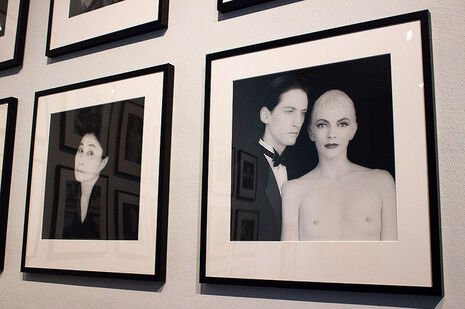A queerer perspective: Leather, latex, and Robert Mapplethorpe
Louis Shankar explores the thought-provoking and controversial art of Robert Mapplethorpe

Robert Mapplethorpe was an American photographer who came to prominence in the late 1960s; now, his photos can easily sell for tens, if not hundreds, of thousands of dollars. A recent HBO documentary sought to explore his art, the man behind the camera, and the controversy that surrounded both. He was openly gay and explored the underground BDSM scene through photography, imbuing his work with an overt, explicit homoeroticism.
He treated a man clad in leather or latex with the same grace that he captured a flower: like a modern Midas with a camera, everything he touched turned to black-and-white beauty. His male nudes stand tall, strong, and solid, eminently sculptural in form; several years ago, an exhibition at the Accademia in Florence paralleled his work with the sculptures of Michelangelo, specifically his David and unfinished Prisoners and Saint Matthew, creating a dialogue between the two artists (albeit a slightly reductive one).
Mapplethorpe flagrantly challenged censorship: his works were often incredibly explicit, particularly works from the X Portfolio. Helmut and Brooks (warning: not for the faint hearted) shows one man, either Helmut or Brooks, fisting the other; it is, to quote the Getty Museum’s description, a “close-up of male buttocks with another male’s hand and forearm inserted in rectum.” Both men are faceless, anonymous. The photograph is carefully composed, though, balanced both in form and in tone. Such works were carefully staged in his studio, “not sex acts per se but re-enactments of sex acts”, copied but importantly transplanted from the bars and clubs of the S&M scene. These were just a part of a bigger picture: he viewed his work as a totality, rendering the entirety of social life as theatre, paralleling the masquerade of BDSM with contemporary fashion.
Exhibitions of his work unfortunately fell into the so-called ‘Culture Wars’ in America. Right-wing politicians and church leaders were attacking left-wing artists and their funding bodies; the obscenity of Mapplethorpe’s photos became a major point of contention, their artistic, social, and moral values endlessly debated and attacked. In 1998, the University of Central England generated separate controversy closer to home: a student trying to develop reproductions of Mapplethorpe’s images for an essay received attention from the police, who intervened and interviewed the Vice-Chancellor, citing the terms of the Obscene Publications Acts.
Beyond this, Mapplethorpe knew various high-profile, radical New York celebrities – Andy Warhol, Louise Bourgeois, Peter Gabriel, Grace Jones – using them as subjects throughout his work. He was a close friend of Patti Smith, a longtime roommate whom he photographed on multiple occasions. “Robert took areas of dark human consent and made them into art,” she later wrote, “he worked without apology, investing the homosexual with grandeur, masculinity, and enviable nobility.” He brought what was deliberately sidelined – gay men, queer masculinity, sadomasochistic sexuality – into the spotlight (both figuratively and literally).
Like Warhol, he created art that unashamedly pictured the penis, looking to male anatomy and pleasure through a homoerotic lens. He deconstructed representations of black men, contesting erotic representations, albeit against criticism of exploitation. Despite this, to quote Smith again, “he was presenting something new, something not seen or explored as he saw and explored it. Robert sought to elevate aspects of male experience, to imbue homosexuality with mysticism.” But he was also “a man of sociopathic ambition who wants sex, fame and money”, courting controversy for attention, celebrating transgression as provocation.
Mapplethorpe died in March 1989 due to complications from AIDS. (This might seem reminiscent of my earlier column on Keith Haring: the similarities are both disturbing and important.) Unlike many other artists in his position, he didn’t explicitly document his illness through his art. He often created self-portraits: in 1978, he photographed himself with a bullwhip in his ass; his 1988 self-portrait with a skull cane obliquely proclaims his imminent death. It is a masterpiece in both vanity and vanitas.
The following year, David Wojnarowicz was filmed with his lips sewn shut for the film Silence = Death, in collaboration with Phil Zwickler and Rosa von Praunheim. Elsewhere, he vehemently attacked the institutional failings that allowed HIV to spread so easily and AIDS to kill so many gay men: the Catholic church banned condoms; Republicans banned needle exchanges; US senator Jesse Helms publicly declared AIDS to be a punishment for homosexuality. At this time, art proved its power to provoke, critique, expose. The power of Mapplethorpe’s images, hidden beneath a veneer of aesthetics, has lasted; his representations of men – as erotic subjects, sexual objects – continue to challenge and inspire.
 News / Cambridge don appointed Reform adviser23 October 2025
News / Cambridge don appointed Reform adviser23 October 2025 Arts / Why is everybody naked?24 October 2025
Arts / Why is everybody naked?24 October 2025 Comment / On overcoming the freshers’ curse22 October 2025
Comment / On overcoming the freshers’ curse22 October 2025 Arts / Why Cambridge’s architecture never lives up to the ‘dark academia’ dream 17 October 2025
Arts / Why Cambridge’s architecture never lives up to the ‘dark academia’ dream 17 October 2025 News / How much does your college master earn?17 October 2025
News / How much does your college master earn?17 October 2025







